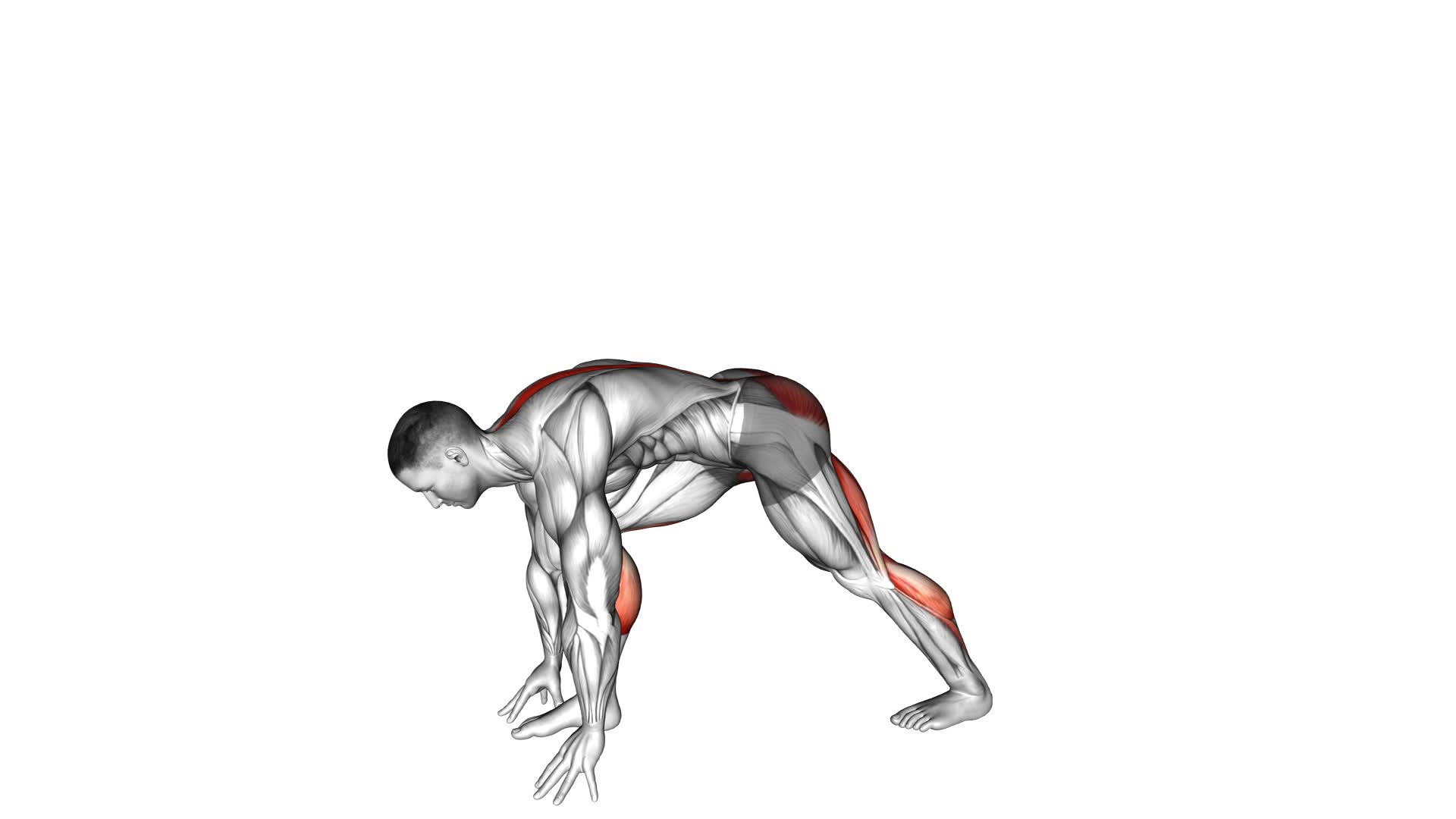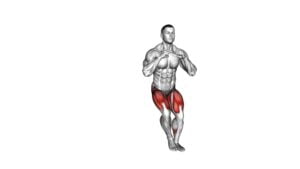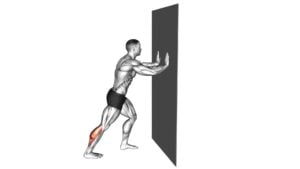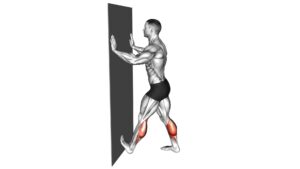Crouching Heel Back Calf Stretch – Video Exercise Guide & Tips

Get ready to stretch and strengthen your calves with the Crouching Heel Back Calf Stretch. In this video exercise guide, we'll show you the proper form and technique to get the most out of this exercise.
Watch This Exercise Video
Avoid common mistakes, modify the stretch for your fitness level, and maximize its effectiveness with our helpful tips.
Remember to always prioritize safety and consider any personal limitations before attempting this stretch.
Let's get started!
Key Takeaways
- The crouching heel back calf stretch improves flexibility, range of motion, and muscle strength in the lower legs.
- This stretch targets the calf muscles, including the gastrocnemius and soleus, and helps lengthen and elongate them.
- It is particularly beneficial for athletes, runners, and individuals requiring quick and powerful movements.
- To perform the stretch correctly, it's important to maintain proper form and technique, including foot positioning and avoiding common mistakes.
Benefits of the Crouching Heel Back Calf Stretch
The crouching heel back calf stretch provides a variety of benefits for your lower legs. By incorporating this stretch into your routine, you can experience improvements in flexibility, range of motion, and muscle strength. This exercise specifically targets the calf muscles, including the gastrocnemius and soleus.
As you perform the stretch, you'll feel a gentle pull in the back of your lower leg, which helps to lengthen and elongate these muscles.
One of the key benefits of the crouching heel back calf stretch is its ability to improve flexibility. The stretch targets the tight muscles in your calves, helping to loosen them up and increase their range of motion. This can be particularly beneficial for athletes, runners, and individuals who engage in activities that require quick and powerful movements.
In terms of duration, it's recommended to hold the stretch for 20-30 seconds on each leg. This allows enough time for the muscles to relax and for the stretch to be effective. It's also important to perform this stretch regularly, ideally 2-3 times a week, to maintain and build upon the improvements in flexibility and muscle strength.
Proper Form and Technique for the Stretch
To perform the crouching heel back calf stretch correctly, focus on maintaining a stable position and activating your calf muscles. Here are some tips to help you achieve proper form and technique for this stretch:
- Start by standing with your feet hip-width apart and placing your hands on a sturdy surface for support.
- Step one foot back, keeping your heel flat on the ground and your toes pointing forward.
- Bend your front knee, making sure it stays aligned with your ankle, and shift your weight onto the front leg.
- Slowly lower your hips towards the ground, feeling a stretch in your back calf.
- Hold the stretch for 20-30 seconds, then switch sides and repeat.
By following these guidelines, you'll be able to maximize flexibility in your calf muscles while also preventing calf injuries.
Maintaining a stable position and activating your calf muscles will ensure that you're targeting the right areas and getting the most out of the stretch. Remember to listen to your body and adjust the intensity of the stretch as needed.
Regularly incorporating the crouching heel back calf stretch into your routine can help improve calf flexibility and reduce the risk of injuries.
Common Mistakes to Avoid During the Exercise
When performing the crouching heel back calf stretch, it's important to avoid improper foot positioning and lack of proper form.
Improper foot positioning can lead to ineffective stretching and potential injury. Make sure to keep your foot flat on the ground and maintain proper alignment throughout the exercise to maximize the benefits and minimize the risk of injury.
Improper Foot Positioning
To ensure proper form and effectiveness during the crouching heel back calf stretch, it's important that you avoid common mistakes by maintaining correct foot positioning. Incorrect foot alignment can lead to reduced stretching technique and potential injury. Here are five common mistakes to avoid:
- Placing your foot too far forward: This can limit the stretch on your calf muscles and put unnecessary strain on your foot.
- Turning your foot inward: This can affect the alignment of your leg and reduce the effectiveness of the stretch.
- Allowing your heel to lift off the ground: Keeping your heel grounded ensures a deeper and more effective stretch.
- Leaning your upper body too far forward: This can compromise your balance and limit the stretch on your calf muscles.
- Not aligning your knee with your toes: Keeping your knee in line with your toes helps maintain proper form and prevents strain on your joints.
Lack of Proper Form
Maintain proper form and avoid common mistakes to ensure the effectiveness of the crouching heel back calf stretch. By doing so, you can prevent injuries and maximize the benefits of this exercise.
Proper form is crucial to target the calf muscles and improve flexibility. One common mistake to avoid is rounding your back. Keep your spine straight and engage your core muscles throughout the exercise.
Another mistake isn't fully extending your back leg. Make sure to straighten your back leg completely to stretch the calf muscles effectively.
Lastly, avoid rushing through the exercise. Take your time and hold the stretch for 15 to 30 seconds on each leg.
Modifications and Variations for Different Fitness Levels
For different fitness levels, you can modify and vary the Crouching Heel Back Calf Stretch exercise to suit your needs. Here are some modifications and progressions you can try:
- Beginner Variation: If you're just starting out, you can perform the stretch while sitting on a chair instead of crouching down. This will provide a less intense stretch for your calf muscles.
- Intermediate Modification: To increase the intensity of the stretch, you can hold a dumbbell or a weighted object in your hands while performing the exercise. This will add resistance and challenge your calf muscles even more.
- Advanced Variation: For a more advanced version of the stretch, you can try performing it on an elevated surface, such as a step or a sturdy block. This will increase the range of motion and provide a deeper stretch for your calves.
- Alternative Position: If you find it difficult to crouch down, you can try performing the stretch while standing with one foot on a step or curb. This will target the calf muscles in a different angle.
- Progressive Variation: As you become more comfortable with the exercise, you can try holding the stretch for a longer duration or increasing the number of repetitions to further challenge your calf muscles.
By modifying and varying the Crouching Heel Back Calf Stretch exercise, you can customize it to your fitness level and gradually progress over time.
Now, let's move on to the next section to discover some tips for maximizing the effectiveness of the stretch.
Tips for Maximizing the Effectiveness of the Stretch
To maximize the effectiveness of the crouching heel back calf stretch, there are a few key points to keep in mind.
First, be sure to focus on your breathing during the stretch, inhaling deeply as you prepare to stretch and exhaling as you release the stretch. This will help relax your muscles and enhance the stretch.
Additionally, it's important to properly warm up your muscles before attempting any stretching exercises to prevent injury and allow for a deeper stretch.
Breathing Techniques for Stretching
Breathe deeply and rhythmically while stretching to maximize the effectiveness of your stretches. Proper breathing techniques during stretching can enhance muscle engagement and promote relaxation. Here are some tips to help you optimize your breathing while stretching:
- Take slow, deep breaths: Inhale deeply through your nose and exhale slowly through your mouth.
- Coordinate your breath with the stretch: Inhale as you prepare for the stretch and exhale as you deepen the stretch.
- Focus on exhaling during the most challenging part of the stretch: This can help you release tension and go deeper into the stretch.
- Avoid holding your breath: Holding your breath can cause muscle tension and limit your range of motion.
- Stay relaxed and maintain a steady rhythm of breath: This will help you stay present and connected to your body.
By incorporating these breathing techniques into your stretching routine, you can maximize the benefits of each stretch and improve your overall flexibility and mobility.
Now, let's move on to the importance of a proper warm-up before stretching.
Proper Warm-Up Before Stretching
Before stretching, it's essential to warm up properly to maximize the effectiveness of your stretch. Warming up helps prepare your muscles for activity and increases blood flow, which can enhance flexibility and prevent injury.
To achieve a proper warm-up, incorporate dynamic warm-up exercises into your routine. Dynamic warm-up exercises involve continuous movement that mimics the motions of the activity you're about to perform. Examples of dynamic warm-up exercises include jogging, jumping jacks, high knees, and leg swings. These exercises help increase your heart rate, warm up your muscles, and improve range of motion.
Safety Precautions and Considerations for the Exercise
Prioritize your safety by following these important considerations for the crouching heel back calf stretch exercise.
- Warm up: Before attempting any stretching exercise, it's crucial to warm up your muscles. This helps to increase blood flow, improve flexibility, and prevent injuries.
- Proper form: Pay attention to your body alignment and technique during the stretch. Keep your back straight, engage your core, and ensure that your heel is firmly on the ground.
- Gradual progression: Start with gentle stretches and gradually increase the intensity over time. Pushing yourself too hard too soon can lead to muscle strains or tears.
- Listen to your body: If you experience any pain or discomfort while performing the crouching heel back calf stretch, stop immediately. It's important to respect your body's limits and avoid pushing through unnecessary pain.
- Consult a professional: If you have any pre-existing injuries or medical conditions, it's recommended to consult a healthcare professional or a qualified fitness trainer before attempting this stretch. They can provide personalized guidance and ensure that the exercise is safe for you.
By following these safety precautions and considerations, you can prevent injuries and maximize the benefits of stretching.
Frequently Asked Questions
How Long Should I Hold the Crouching Heel Back Calf Stretch?
To improve calf muscle flexibility and reap the benefits of stretching calf muscles, it's important to hold the crouching heel back calf stretch for an adequate amount of time.
The duration of the stretch depends on your fitness level and goals. Generally, holding the stretch for 20 to 30 seconds is a good starting point. As you progress, you can aim to hold it for longer periods, up to 60 seconds, to further enhance flexibility and range of motion.
Can I Do This Stretch if I Have a Previous Calf Injury?
If you have a previous calf injury, it's important to be cautious when doing the crouching heel back calf stretch. Before attempting this stretch, consult with a healthcare professional who specializes in calf injury rehabilitation.
They can provide you with modifications to ensure the stretch is safe and effective for your specific injury. Remember to always prioritize your safety and listen to your body's signals during any exercise or stretching routine.
Is It Normal to Feel Discomfort or a Burning Sensation in the Calf While Performing This Stretch?
Feeling calf muscle discomfort or a burning sensation during this stretch isn't uncommon. It could indicate that your calf muscles are being stretched and worked.
However, it's important to ensure you're using proper form when performing the crouching heel back calf stretch to minimize any discomfort.
Make sure to maintain a stable posture, keep your heel grounded, and avoid excessive strain on the calf muscles.
Can I Use a Towel or Strap to Assist in the Stretch?
Yes, you can definitely use a towel or strap to assist in the stretch. This modification can help you achieve a deeper stretch and provide additional support.
Simply wrap the towel or strap around the ball of your foot, holding onto the ends with your hands. Gently pull back on the towel or strap to increase the stretch.
Remember to listen to your body and only go as far as is comfortable for you.
How Often Should I Incorporate the Crouching Heel Back Calf Stretch Into My Exercise Routine?
To determine how often to incorporate the crouching heel back calf stretch into your exercise routine, consider your current fitness level and goals. Beginners may want to start with 2-3 times per week and gradually increase frequency as their flexibility improves.
This stretch can be modified for beginners by using a towel or strap to assist in the stretch.
The benefits of incorporating this stretch include improving calf flexibility, reducing the risk of injury, and enhancing overall lower body mobility.
Conclusion
In conclusion, the crouching heel back calf stretch is a beneficial exercise for improving flexibility and mobility in the calf muscles.
By maintaining proper form and technique, avoiding common mistakes, and making modifications for different fitness levels, individuals can maximize the effectiveness of this stretch.
However, it's important to consider safety precautions and listen to your body during the exercise to prevent any potential injuries.

Author
Years ago, the spark of my life’s passion ignited in my mind the moment I stepped into the local gym for the first time. The inaugural bead of perspiration, the initial endeavor, the very first surge of endorphins, and a sense of pride that washed over me post-workout marked the beginning of my deep-seated interest in strength sports, fitness, and sports nutrition. This very curiosity blossomed rapidly into a profound fascination, propelling me to earn a Master’s degree in Physical Education from the Academy of Physical Education in Krakow, followed by a Sports Manager diploma from the Jagiellonian University. My journey of growth led me to gain more specialized qualifications, such as being a certified personal trainer with a focus on sports dietetics, a lifeguard, and an instructor for wellness and corrective gymnastics. Theoretical knowledge paired seamlessly with practical experience, reinforcing my belief that the transformation of individuals under my guidance was also a reflection of my personal growth. This belief holds true even today. Each day, I strive to push the boundaries and explore new realms. These realms gently elevate me to greater heights. The unique combination of passion for my field and the continuous quest for growth fuels my drive to break new ground.







